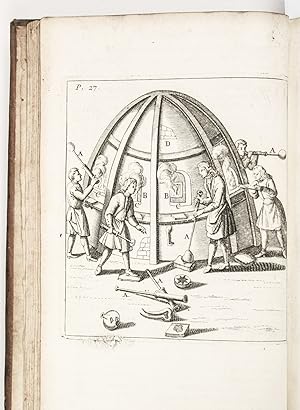Glass Chemistry Haudicquer Blancourt Jean (1 results)
FeedbackSearch filters
Product Type
- All Product Types
- Books (1)
- Magazines & Periodicals (No further results match this refinement)
- Comics (No further results match this refinement)
- Sheet Music (No further results match this refinement)
- Art, Prints & Posters (No further results match this refinement)
- Photographs (No further results match this refinement)
- Maps (No further results match this refinement)
- Manuscripts & Paper Collectibles (No further results match this refinement)
Condition
- All Conditions
- New (No further results match this refinement)
- Used (1)
Binding
- All Bindings
- Hardcover (1)
- Softcover (No further results match this refinement)
Collectible Attributes
- First Edition (1)
- Signed (No further results match this refinement)
- Dust Jacket (No further results match this refinement)
- Seller-Supplied Images (1)
- Not Print on Demand (1)
Free Shipping
- Free Shipping to United Kingdom (No further results match this refinement)
Seller Rating
-
The art of glass.Shewing how to make all sorts of glass, crystal and enamel. Likewise the making of pearls, precious stones, china and looking-glasses. To which is added, the method of painting on glass and enameling. Also how to extract the colours from minerals, metals, herbs and flowers. A work containing many secrets and curiosities never before discovered. Illustrated with proper sculptures. Written originally in French, by Mr. H. Blancourt, and now first translated into English. With an appendix, containing exact instructions for making glass-eyes of all colours
Published by printed for Dan. Brown at the Black Swan without Temple-Bar; Tho. Bennet at the Half-Moon, D. Midwinter and Tho. Leigh at the Rose and Crown, and R. Wilkin at the King's-Head in St. Paul's Church-yard, London, 1699
Seller: Liber Antiquus Early Books & Manuscripts, Chevy Chase, MD, U.S.A.
First Edition
Hardcover. Condition: Fine. Bound in contemporary English paneled calf, rebacked. Very fine condition. Two plates lightly browned, marginal foxing to a few leaves. Illustrated with 9 engraved plates of glass-making furnaces, tools, crucibles, and other apparatus. The core of Blancourt's text is Christopher Merret's annotated Latin edition (1668) of Antonio Neri's "L'Arte Vetraria"(1612). Merret had produced his own English (unillustrated) translation of Neri's work in 1662. Among Blancourt's notable contributions to the text are a chapter on crystal, glass and metal mirrors; and an appendix on a secret technique for making glass eyes look "Very Natural". "Antonio Neri's'L'Arte Vetraria'as the first printed book solely devoted to the art of glass formulation. It is a work committed to the subject of refining raw materials and combining them into a range of glasses and a rainbow of colors. The book divides into seven parts, each devoted to a different aspect of the glassmaker's art. He starts with the basics: preparing the fundamental ingredients of glass. Next, he combines those materials into "cristallo." Named after its mineral cousin, rock crystal,cristallowas a sophisticated Venetian specialty renowned for its delicate clarity. Neri details its traditional composition as brought to the Medici court by Venetian masters and then innovates with variations of his own. "At the other end of the spectrum is his "common" glass used for daily utilitarian purposes. He shows the standard formulas used in shops throughout the region and then proceeds to improve upon them. He presents a gamut of colors as well as advice for the glass "to emerge in full beauty and perfection." He shows the way to decolorize glass, to take away even a slight tinge of hue that may be present and bring the melt to perfect crystal clarity. He walks us through numerous recipes in preparation for making an iconic Renaissance glass, including the exquisite chalcedony-engineered to replicate the swirling colors of its namesake mineral. Beautiful to behold and thought by many to engender mystical properties, Neri describes it as "adorned with so many graceful and beautiful areas of undulations and enhanced with the play of diverse, lively, flaming colors." He goes on to describe leaded glasses, artificial gems, enamels and glass paints. Each time he innovates, each time he guides us with encouragement, admonition and painstaking clarity. "That Neri's book was the first of its kind in print is a notable distinction, but one that his deeper accomplishment easily surpasses;'L'Arte Vetraria'preserves a rare glimpse of skilled practical knowledge. In his era, prized techniques were frequently lost to subsequent generations, lost because artisans so often spared the pen. Their precious knowledge went purposely unrecorded, passing in strict confidence from master to apprentice working side by side. In 1612, Neri published his expertise to the world, preserving the techniques and science of glass practices, but also its art. Just as a great painter relies on the quality of pigments at hand, so must a master glass artisan depend upon the materials of the melt. For the glassblowers and furnace workers who shaped hot glass, a superior batch was crucial to superior results. A great piece of glasswork owes its form to the talent of the artist, but its substance is the province of the craftsmen who make the glass. "Neri wrote'L'Arte Vetraria'shortly before his death at the age of thirty-eight. Soon after, Galileo sent it to a friend in Rome, who was anxious for a copy."(Paul Engle, "Antonio Neri, Alchemist, Glassmaker, Priest", Corning Museum of Glass). FIRST ENGLISH EDITION of Jean Haudicquer de Blancourt's "De l'artde la verrerie".


